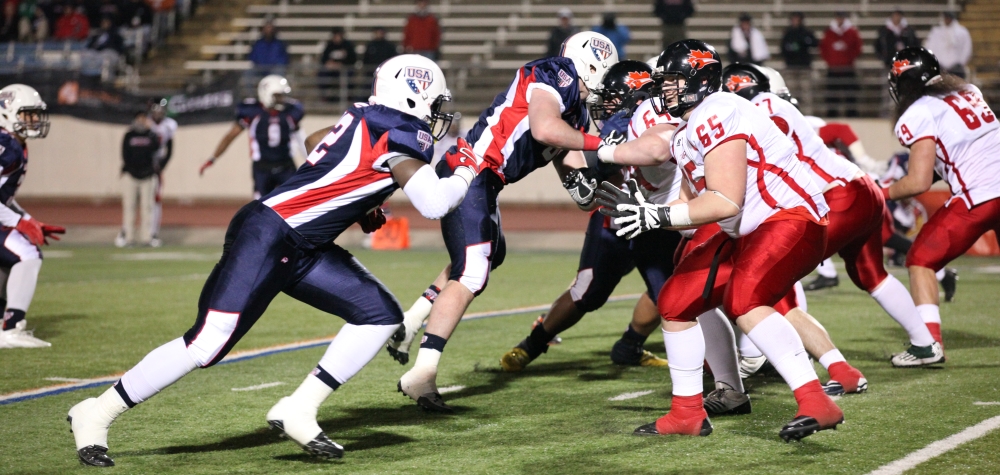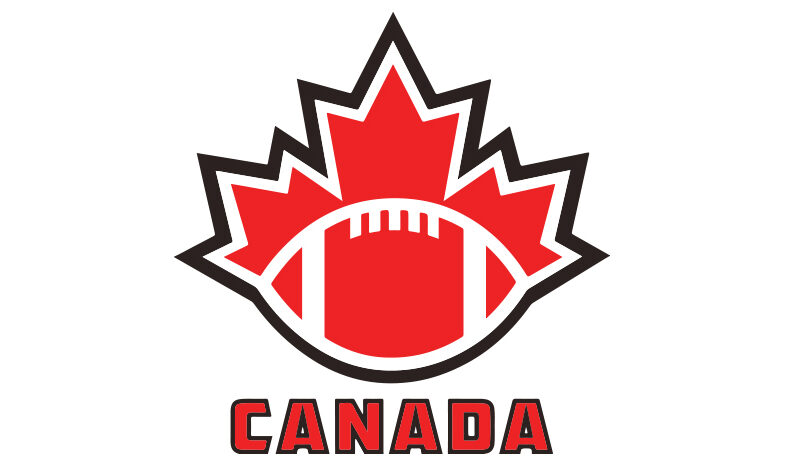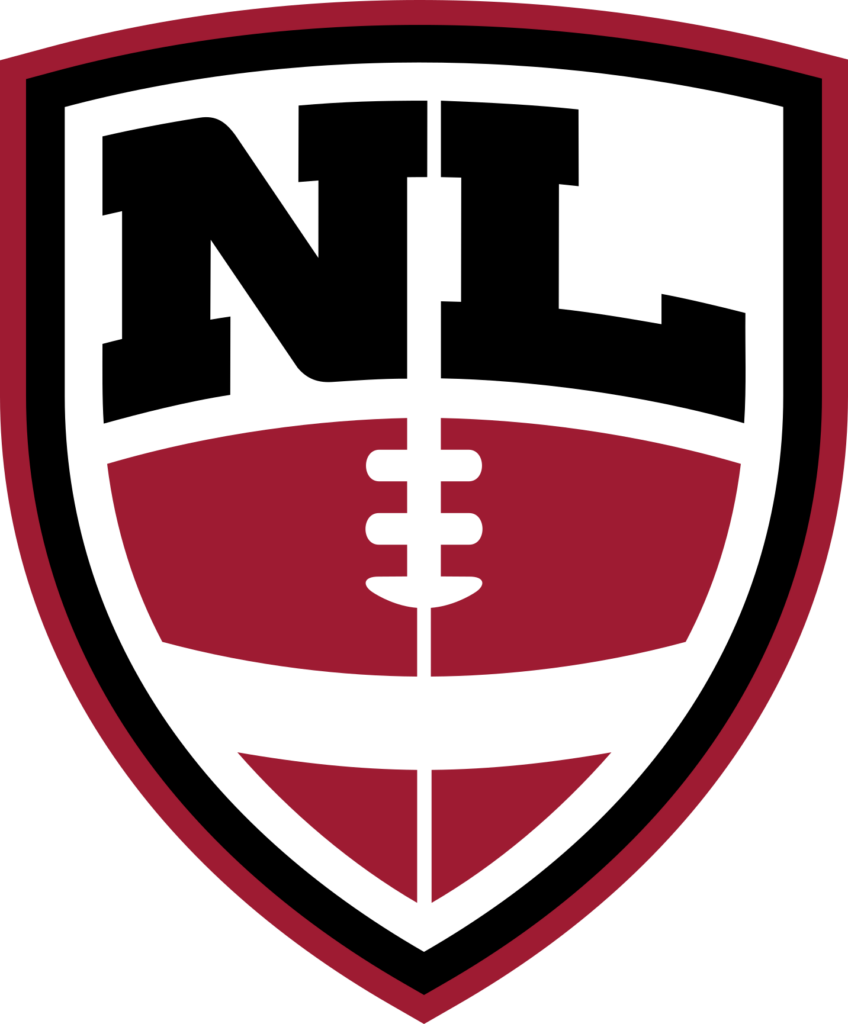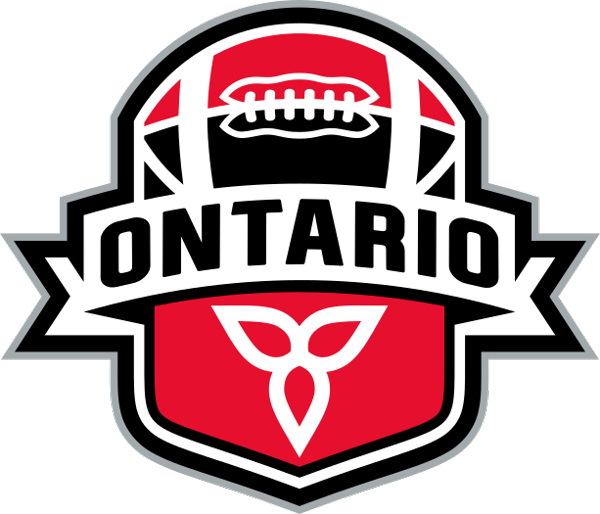Texas trip helps Team Canada adjust to international rules
Photo: USA Football
Football Canada’s under-18 and under-19 national teams will compete at the 2016 International Bowl series, January 31-February 5, at AT&T Stadium in Arlington, Texas.
Players on Canada’s national teams not only compete for their nation’s pride against top American recruits, but also hope to catch the eye of the Junior National Team coaching staff who will use competition to select 45-players to represent Canada at the IFAF U19 World Championship in July 2016.
As international competition uses the NCAA rulebook, Canada’s players and coaches must modify their game accordingly.
This transition to the international (i.e. 4-down) game is much more complex than simply adding an extra down of play and moving from 12 to 11 players on the field.
For starters, in American football, the offensive and defensive lineman directly oppose on another on the line of scrimmage instead of lining up one yard apart, as they do in the Canadian game.
“From a defensive line perspective, taking away that yard, you just have to be ready to be far more physical and far more hands-on,” defensive line coach, Brian Guebert said. “It’s a necessity that you get your hands on the guy across from you and really own that line of scrimmage. With great quickness, you can really take-over and not giving up that yard makes you that much more dangerous of a player.”
“Other than the extra down, you need to be sure of your run defend technique – staying low, moving your feet, staying square, and just being able to battle those double-teams, recognizing tight ends, and all those sorts of things that are maybe a little more unique to the American game.”
As Canada’s special teams coordinator, in addition to his role as defensive line coach, Guebert must also help his players adjust to the new kicking game. The American game pushes the goal posts to the back of the end zone rather than on the goal line, as they are in the Canadian game. The extra ten yards changes the distance required for teams to enter field goal range.
“Ultimately, the offence has to get it to the 30-yard line for a 48-yard field goal,” Guebert explained. “When we’re talking about the U19 team, 47-48 is probably getting near our limits in terms of the kickers we get to work with.”
The addition of the fair catch, in the American game, also impacts punt cover strategy.
“You need to be more prepared and play that positional game, understanding when to punt, and how to punt it with great hang-time. In the Canadian game, punting is far more directional, you want to get it out of bounds, you want to cut the width of the Canadian field in half. You’re not as worried about that in the American game, but you do want to get that hang-time so that you can get your players down there and hopefully force the fair catch or down the ball near the goal line of your opponent.”
Canada’s offensive and defensive coordinators must also adjust their play calling to suit international rules, taking into account the extra down of play, one less player on the field, new field dimensions, variations in the amount of time on the play clock and restricted offensive motion.
Canada’s U19 national team’s game on January 31 will mark the second-straight year that Canada’s Junior National Coaching staff will coach together at the International Bowl in preparation for the worlds.
Even as a former Team Canada positional coach and long-time defensive coordinator at the Canadian university level, the transition has taken some getting used to for Kevin MacNeill who took over defensive play calling from current head coach Warren Craney, a year ago in Texas.
“Going down from 12 players to 11 players in American rules was the biggest adjustment,” MacNeill said of his 2015 International Bowl experience. “Having a smaller playing surface and less motion is something that really helps the defence and allows us to do more things which is a lot of fun.”
Coaches gain flexibility to open up the offensive playbook in international competition with the addition of a fourth down of play.
“From an analytics perspective, it provides another down statistically that you have to account for in terms of what they (the offence) will do,” MacNeill said. “That definitely added to the game plan and the preparation for play calling and having those different scenarios.”
“In Canadian football, we go from being in first-and-ten, second-and-short, medium or long more often to now [with American rules], having a ton of additional scenarios and offensive flexibility between run and pass on 1st and the middle downs, creating more of a chess game that you have to be aware of.”
Canada’s International Bowl experience is priceless as they work towards the worlds.
“Those International Bowl experiences of playing American football against Team USA are something that you can’t put a price-tag on from the standpoint of what it means to this program and these kids,” explained Junior National Team head coach, Warren Craney. “In the end, football’s football but there’s a lot of nuances to the U.S. game that take some getting used to. There are nuances and being able to play those friendlies going into the tournament helps this team so much and their confidence.”
Team Canada’s International Bowl experience should help the team acclimatize to the 4-down brand of football before they take the field at the 2016 IFAF U19 World Championship in July.
Following Canada’s U18 and U19 national team’s games at AT&T Stadium, home of the Dallas Cowboys in Arlington, the Junior National Team will select 45-players to represent Canada at the 2016 IFAF U19 World Championship.
Follow Canada at the International Bowl by visiting www.footballcanada.com on game day as well as Football Canada on Facebook, Instagram and Twitter. Use the hashtag #IB2016 to join the conversation.







